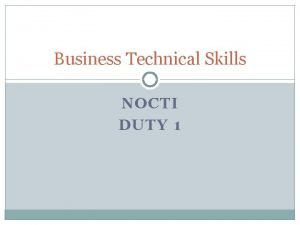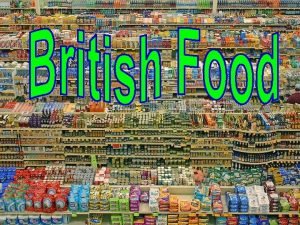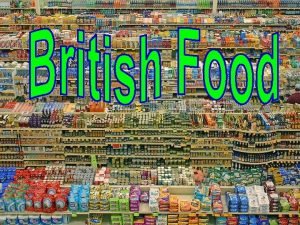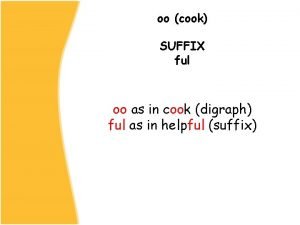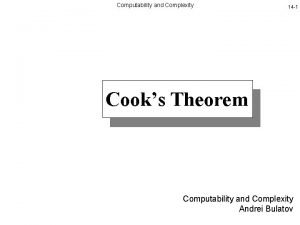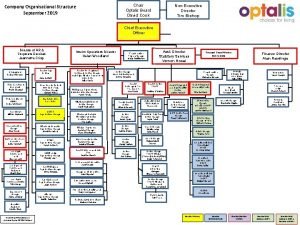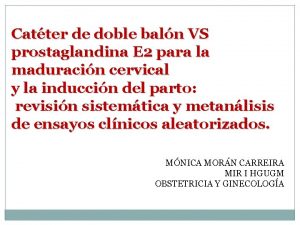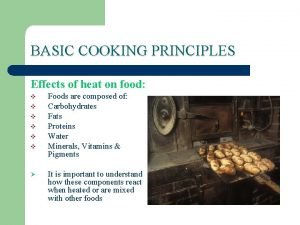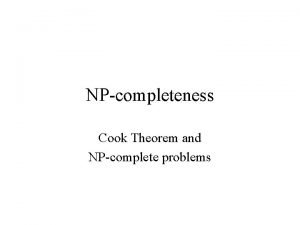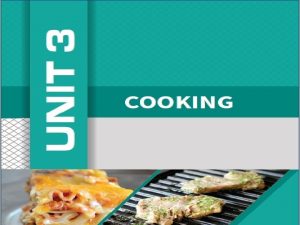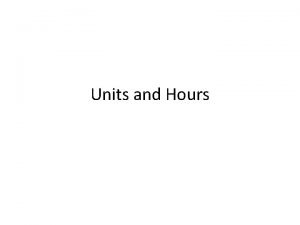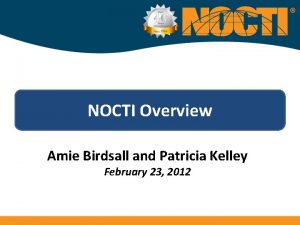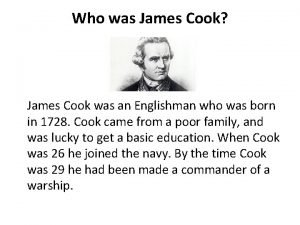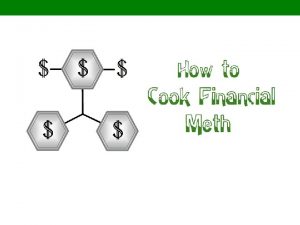Review for NOCTI Cook 2 test 3 hours













































































































- Slides: 109

Review for NOCTI Cook 2 test – 3 hours, 2 sessions Based on information from Foundations Textbooks

Standardized Recipe �Written in a format that is clear to anyone who uses it �Critical to control cost, quality and consistency of product �Ingredients are listed in order of use

Recipe �Title �Ingredients �Amounts �Time and Temperature �Yield – how many or how much �Method - Directions

Measuring �Measure wet and dry ingredients �Equivalents ◦ 16 T = 1 cup ◦ 3 teaspoons = 1 Tablespoon ◦ weight use a balance scale or digital scale ◦ 30 grams = 1 ounce ◦ 480 grams = 1 pound

Wet or Liquid � 8 fluid ounces = 1 cup � 2 cups = 1 pint � 2 pints = 1 quart (32 ounces) � 4 quarts = 1 gallon (128 ounces) �Equipment: liquid measures and ladles

Gallon Man

Conversion Factor CF �What you want divided by what you have is the formula �New divided by old �Example: need 48 brownies, recipe yields 24 ◦ ◦ 48 divided by 24 = 2 CF is 2 Multiply by 2 �Bread is by count – 2 slices per sandwich unless it is a multidecker sandwich

AP/EP Amounts �A/P means as purchased �E/P is edible portion – what remains after trimming and cleaning �A/P amount is always larger than the E/P because you have trimmed away part of the product – Example, a peeled and trimmed potato is less than original weight

Terms for cooking �Mise en place = everything in it’s place �Saute �Braise �Blanch �Temper

Sanitation �Food handlers – anyone who handles food including servers �Food handlers – no jewelry except plain band ring, no nail polish or acrylic nails �Handwashing – 20 second scrub with hot water – 105 degrees �Bandage wounds �Wear gloves when handling ready to eat food

Sanitation �Staph infections contaminate from open cuts �Sore throat and fever – cannot work around food �Stay home with vomiting, diarrhea or a diagnosed foodborne illness

Foodborne Illness �Foodborne illness – disease transmitted to people by food �Foodborne illness outbreak – 2 or more people sick from same food �CDC – Center for Disease Control monitors foodborne illness �High risk populations- very young children, elderly and people with chronic illness – have undeveloped or compromised immune system

Three Categories of Contamination �Biological pathogens contaminate food �Chemicals remain on food due to improper washing (produce) or cleaning chemicals get into food �Physical Hazards fall into food such as a hair, fingernail or a natural hazard remains in food such as fish bone

Biological Contaminants � 4 types of pathogens ◦ Viruses (Most common way food is contaminated) ◦ Bacteria ◦ Parasites ◦ Fungi ◦ 5 th type may be toxins or poisons ◦ Contaminants can survive freezer temps.

Foodborne Illness �E-Coli Beef, ground meat and dairy �Salmonella – poultry, eggs, chicken � Botulism Canned Goods �Staphylococcal Aurous From cuts, wounds

FATTOM �Acronym for conditions that promote bacteria to grow �F Food protein, heat treated grains �A Acid food with little or no acid �T Time time in danger zone �T Temperature 41 - 135 degrees �O Oxygen �M Moisture

Sanitation �Cross Contamination – pathogens move from one food to another �Time temperature abused - when food is left in danger zone �Temperature danger zone – 41 – 135 degrees �Only way to monitor is with thermometer

Thermometers �Bimetallic Stemmed �Thermocouple and thermistor �Surface probe checks only surface temp – such as grill temp. �Take temperature in thickest part of meat and hold temp. for 15 seconds

Receiving �Cold food receiving temps between 41 and 32 degrees �Eggs – receive temp of 45 degrees or lower �Frozen foods – 32 degrees or lower. Check for ice in packages

Prep �Thaw food in cold water, in refrigerator or microwave – (cook immediately if thawed in micro. ) �It is acceptable to thaw some foods as part of cooking process – such as burgers on grill in frozen state

Cooking � 165 degrees Poultry � 155 degrees – ground meat and eggs that will be hot held for service � 145 degrees – Seafood, steaks, chops and pork. Eggs served immediately. Roasts � 135 degrees commercially processed ready to eat food that will be hot held such as cheese sticks � 135 degrees Vegetables and grain

Prevent cross contamination �Clean and sanitize workstations, cutting boards and utensils after use, changing tasks and 4 hours �Keep ready to eat away from raw meat/seafood �Have different, separate work stations �Limit time in danger zone

HACCP � 7 principles to identify major hazards during any point in flow of food �Hazard Analysis Critical Control Point �Principles 1 & 2 identify and potentially hazardous food on menu �Principles 3, 4 and 5 establish prevention methods such as monitoring temperatures �Principles 6 & 7 verify and assess system works

HACCP Terms �Critical Control Point – point in flow of food where contamination may occur �Critical Limit – requirement that can be measured such as cook chicken to 165 degrees for 15 seconds

Cleaning and Sanitizing �Cleaning removes surface dirt �Sanitizing reduces pathogens to a safe level �Surfaces ◦ ◦ Clean Rinse Sanitize Air dry – order of work

3 compartment sink �Clean �Rinse �Sanitize (chemical sanitizer)

Master cleaning schedule �What is to be cleaned �Who is to clean �When it should be cleaned �How it should be cleaned

Knives �Chef Knife French Knife All purpose �Paring Knife Trim Vegetables and Fruit �Boning Knife Take meat/poultry from bone �Bread Knife Serrated edge �Slicer �Butcher – Scimitar Long curved blade �Cleaver – chops through bones, etc.

Parts of a Knife �Point �Tip �Blade �Back �Heel �Tang �Bolster

Parts of a knife

Sharpening a Knife �Sharpening stone to grind and hone edges �Sharpen at 20 degree angle to stone �Honing steel – removes broken pieces and realign the blade

Knife Safety �Keep knives sharp �Use for intended purpose �Do not put in dishwasher �Do not leave soaking in water �Do not point at anyone �Allow dropped knives to fall �Do not hand knife to another person

Knife Cuts Four Categories: Mince Slice Sticks Cubes

Knife Cuts and Techniques �Sticks ◦ ◦ ◦ Batonnet 2 ½ by ¼ stick cut Julienne 2 ½ by 1/8 cut Fine Julienne 2 ½ by 1/16 �Cubes: ◦ ◦ Large Dice Medium Dice Small Dice Brunois

Other Cuts �Concasse �Tourne’ Rough Cut (tomato) 7 sided football cut

Receiving and Storage Equipment �Receiving table – inspect goods being received �Scales – weigh to match against what is ordered �Utility carts – to move food items �Shelving – stainless steel �Refrigerators – walk in and reach in

Cooking Methods �Heat transfer Conduction Convection Radiation

Cooking Methods – Dry, Moist and Combination Dry heat the food must be tender or you may need to add moisture: Barding - Wrap lean meat with bacon Larding – Insert strips of fat into meat Marinating – soak in combination of wet and dry ingredients

Dry Methods without fat �Broil Heat source above food �Grill On grill rack away from heat source �Roast Dry heat – oven Longer than baking �Bake Dry heat - oven

Dry with Fat �Griddling �Saute’ �Stir Fry �Pan Fry and Deep Fry

Moist Heat Methods �Simmering Submerged in liquid just below boiling �Poaching and Shallow poaching 160 – 180 degrees. Shallow has combination of liquid and steam – good for delicate fish �Blanching Drop in boiling water, partial cook Then ice bath, finish elsewhere �Steaming Above the liquid in steam basket

Combination �Good for less tender meats �Braising – large cuts of meat – Seared then cooked partially covered in liquid ◦ Low and Slow Cooking �Stewing – smaller cuts that are blanched or seared and then cooked in liquid

Plating and Portioning �Portioning is how much to serve – overportioning results in lower profit �Plating is decision as to how to serve �Garnish enhances the food – edible and simple

Nutrition and Cooking �Dietary Guidelines – fruits, vegetables, whole grains and low fat milk products �Recommended Dietary Allowances – Nutrient standards for Americans �My Plate replaces My Pyramid – Guide to eat a balanced diet

Nutrients �Protein – builds body tissue – meat, poultry and dairy. 15% Daily Intake �Carbohydrates - Provide Energy Whole grains, sugars in fruits and vegetables (35% of daily intake) �Fats – Choose Unsaturated (liquid) when possible. 35% daily intake

Nutrients �Vitamins �Minerals �Water �About Fat: Hydrogenated fats are solid at room temperature – Solid, least healthy

Vitamins �Fat Soluble A, D, K, E ◦ (Americans Don’t Kill Elephants) ◦ Store in body in fat �Water Soluble ◦ B vitamins and C ◦ C deficient scurvy

Salt �Reduce salt �Too much salt causes hypertension which is high blood pressure

Workplace Safety �OSHA – Occupational Safety and Health Administration – In charge of Workplace Safety �Fires ◦ Class A Paper and Wood (Ash) ◦ Class B Oils and boiling liquids (Boil/Burns) ◦ Class C Electrical (circuits/cords)

Fires �Use the appropriate extinguisher – A/b/C or combination �PASS system ◦ Pull pin, Aim at base, Squeeze trigger, Sweep side to side

Lifting Safely �Test the load �Bend with knees, lift with legs (no back)

First Aid �CPR – Cardiopulmonary Resuscitation �Heimlich Maneuver – Opens airways of person who is choking �MSDS Sheet – Information about chemicals used in workplace – must be kept in a notebook, easily accessible to employees

How the workplace is organized �Kitchen Brigade – organized by Escoffier �Executive Chef – administrator �Sous Chef - under executive chef �Station Chefs: ◦ Garde Manger Cold kitchen ◦ Poissoner Fish Chef ◦ Expediter checks food coming from kitchen ◦ Patissier pastry chef

Service Station �Area that operation keeps napkins, silverware, cups, condiment, menus, etc. �Service Tools – servers may carry a hand towel, lighter, corkscrew, pen, order pad and crumber

Service Styles �Plate service – plate in kitchen �Family style – American – serving dishes on table �Russian – most formal serving from trays �French – serve from a cart gueridon

Front of house organization �Maitre d’ manager of dining room �Wine steward – in charge of wines �Headwaiter in charge of all service �Captains explains menu and tableside prep �Front waiter – waits on tables �Back waiter – similar to busboy

Stocks �Four parts: ◦ Flavoring ingredient ◦ Liquid – usually water ◦ Mirepoix 50% onion, 25% carrots, 25% celery ◦ Aromatics (herbs, bouquet garni or sachet depices

Stocks �White – clear and pale – poultry �Brown – amber color, brown bones first �Fumet – fish stock �Court bouillon – vegetable �Glace – jelly like stock �Jus – from roasted meat �Vegetable

Degreasing Stock �Degreasing is cooking stock and removing fat – lift or scrape fat ◦ Gives more pure color and reduces fat

Sauces �Saucier makes the sauce �Five classic grand sauces or mother sauces ◦ ◦ ◦ Bechamel – milk and white roux Veloute – veal, chicken or fish Brown – brown stock and brown roux Tomato Hollandaise – Egg and lemon Used in eggs benedict (egg, canadian bacon and hollandaise)

Thickening Sauces �Roux – equal parts flour and fat, cooked �Beurre Manie – equal parts flour and butter �Slurry – Cornstarch mixed with cold water �Liaison – egg yolks and cream

Soups �Clear soup – flavored stocks and broths - chicken noodle and minestrone �Thick soups – cream and puree soups such as chowders, cream of tomato

Soups �Bisque – from pureed shellfish shells �Chowder – potato and pieces of main ingredient �Gazpacho – Tomato/Cucumber �Borscht Beet Soup �Vichyssoise Cold potato soup

Fruits �Summer: berries, cherries, grapes, melons ◦ Drupes have a central pit such as peaches, nectarines �Winter ◦ – Apples and pears (Pomes – central core with small seeds ◦ Citrus – lemons, limes, grapefruit and oranges (zest is grated rind – pith is white) �Tropical- pineapple, mango, figs, kiwi

Fruits �Quality grade is rating system ◦ Extra fancy, US No. 1, 2 and 3 ◦ Most used are US Fancy �Storing: 41 degrees or lower �Ethylene gas is emitted from fruits – causes ripening. Can cause spoilage �Wash just before using �Enzymatic browning is oxidation – turns brown Add acid such as lemon juice

Vegetables �Flower vegetables – broccoli, cauliflower �Fruit vegetables – tomato and pepper �Green and leafy – lettuce and greens �Seed vegetables – corn and beans �Root vegetables – turnip and carrots �Tubers – potatoes �Stem vegetables – celery and asparagus

Vegetables �Hydroponic farming – grown indoors with nutrient rich water �Same quality grades as fruit – extra fancy, US grade 1, 2 etc. �Store tubers and roots in cool, dry p lace �Refrigerate other vegetables, wash when ready to use. �Overcooking destroy nutrients Avoid long holding times

Cooking Fruits and Vegetables �Retain nutrients �Avoid long holding times �Broil, Bake, Poach, Steam healthy vegetables �Fried, Creamed not so healthy

Grains and Legumes �Foundation of world’s food supply �Inexpensive and plentiful �Source of complex carbohydrates �Legumes are seeds from pod producing plants �Grains are grasses

Legumes �Soak to shorten cooking time – throw away any that rise to the top �Rinse canned beans to eliminate salt �Use as protein alternative �Boiling is most common cooking method

Grains �Grasses that grow edible seeds �Whole grains – have not been milled �Bran is source of fiber �Endosperm is starch (white bread) �Germ is rich in nutrients �Grains of America – wheat, oats, rye, corn, buckwheat, barley and rice

Store Grains �Cool, dry place 6 inches from floor �Long shelf life �Cooked grains are a potentially hazardous food

Pilaf �Saute the grain or rice �Then bake in oven (can be done on stovetop) �Adding acid lengthens cook time

Risotto �Arborio Rice �Labor intense cooking time �Is a creamy rice – stir while cooking to release starch for a creamy product

Pasta and Dumplings �Inexpensive and versatile �Pasta made from semolina flour �Cook Al Dente – to the tooth, with a bite �Use lots of water – pasta must bounce �Dumplings – dough or batter ◦ Spaetzle – German ◦ Gnocchi – potato (or cheese) Italy ◦ Pieroghi - Polish

Rice �Ratio to cook – 2 water to 1 rice �Do not stir – absorbs water �Stirring will produce a gummy rice product

Breakfast Food �Quickbreads – chemical leavening agent ◦ Pancakes batter ◦ Crepes Batter ◦ Waffles �Breakfast Meats ◦ Bacon 70% fat – shrinks Bake on baking sheet in oven ◦ Canadian Bacon is boneless pork

Breakfast �Hash – chopped meat, potato and onion ◦ Uses leftover meat. �Hash brown potatoes – Steam or simmer potato, then peel, chill, shred and cook on grill

Breakfast Drinks �Traditional beverages are coffee, tea and hot cocoa �Coffee – start with fresh, cold water �Clean coffee urns with 1 part white vinegar to 4 parts water. Rinse 3 times with cold water through brew cycle �Tea – less expensive �Barista is employee who makes coffee drinks

Sandwiches �Open faced �Grilled �Deep fried – Monte Cristo turkey and/or ham and swiss. Egg dipped and fried �Multi-decker – Club �Canape – open face hors d’ouvre �Pullman loaf is sliced white sandwich bread

Parts of a sandwich �Bread �Spread �Filling �Garnish

Dairy �Receive dairy at 41 degrees or lower � Ripened Cheeses Hard cheese are aged and have longer shelf life – cheddar, swiss �Unripened cheese has short shelf life – cottage cheese Ricotta Italian Cottage Cheese �Refrigerate all dairy

Alternatives to cow’s milk �Soy milk �Almond Milk �Rice milk �Goat’s milk

Meat �Quality grade by USDA ◦ Prime ◦ Choice ◦ Select �Cooking method determined by cut �Most tender cuts from least used muscle area

Cuts of Meat �Primal cuts are the first cuts made to animal �Fabrication is butchering the primal cuts into useable portions such as roasts or steaks. �Retail cuts – ready for sale �Game meat – wild animals such as deer �Kosher meat – slaughtered according to Jewish dietary laws

Poultry �The most versatile protein �Graded by the USDA �Grade A, B or C A is the highest grade �Basic cut of chicken is 8 piece cut �Receiving – look for color, firm flesh, no odor �Cook until no pink and juices run clear �Salmonella is disease associated with poultry

Fish and Seafood �Seafood is categorized ◦ Fin Fish such as flounder, cod, shark, swordfish ◦ Shellfish clams, shrimp �Shucked means shell has been removed Freshwater Fish – trout, perch, catfish Pinbones are tiny bones found in fish – can be a hazard for choking - remove

Charcuterie �Sausage and Force Meat �Sausage is ground meats put in a casing �Forcement is lean ground meat and fat made into a paste – pate’

Salads �Parts of a salad: ◦ Base usually greens that line the plate ◦ Body main ingredient – vegetables, meat ◦ Garnish enhances appearance and complements taste – such as green pepper julienne ◦ Dressing flavor salads, act as sauce

Types of Salads �Green Salad – tossed or composed ◦ Tossed – ingredients are mixed together, composed means not mixed together �Bound – ingredients held together with heavy dressing such as mayonnaise tuna salad �Vegetable – heavy dressing binds such as coleslaw �Fruit �Combination – any of above combined

Salad Dressings and Dips �Vinaigrette – 3 parts oil to 1 part vinegar (or acid) �Suspension is temporary mixing of ingredients �Emulsified – mixed together permanently such as mayonnaise which is eggs and oil but does not separate �Mayonnaise has high ratio of oil to vinegar and eggs

Dips �Enhance foods flavor �Hot or cold dips popular �Guacamole – Avocado dip Aztec origins �Salsa – peppers and tomato Mexico �Hummus Chickpeas, garlic and tahini (sesame paste) Mideastern

Inventory and Storage �Physical Inventory – physically review inventory on regular basis �Perpetual Inventory – record what/when received and the record when items are used. �FIFO – First In First Out – stock rotation �Par Stock – an amount always on hand – such as never go below 20 cans crushed tomato �Stockout – Run out of something

Storage �Perishable – short shelf life such as meat, dairy. Purchase in JIT Just in Time Format �Non perishable – long shelf life. �Refrigerated storage – below 41 degrees �Frozen – below 32 degrees �Dry storage – dry and canned good ◦ Open shelves, 6 inches from ground

Canned Goods �Long shelf life – cool and dry area �Check dates on cans �Check for dents and rust - (Botulism) �Sizes ◦ #10 can is institutional size 96 ounces

Baked Goods Bakeshop Basics �Strengtheners – flour and eggs �Fats/Shortening – butter and oil �Sweeteners – sugar and syrups �Flavoring – vanilla �Leaveners – chemical, organic and physical �Thickeners – cornstarch and flour and eggs �Liquids – water, milk, cream �Additives – example food coloring

Bakers Measurements �Bakers use formulas �Flour is always used with proportion of 100% �Ingredients are calculated in percentages �Sifting adds air

Yeast Breads �Organic leavener is yeast �Lean dough – flour, yeast, water and salt ◦ French bread is example �Rich dough – have fat, sugar, eggs ◦ Danish pastry, croissants, parker house rolls

Dough Methods �Straight dough – ◦ Combine all ingredients at one time ◦ Or, may activate yeast and then add other ingredients �Sponge method ◦ Add yeast with half liquid and flour – let rise and then add remaining ingredients �Kneading develops the gluten �Proof – second rise doubles in size ◦ Professional use a proofing cabinet or

Quick Bread �Include muffins, scones, biscuits �Leavener is chemical – baking powder or baking soda �Batter is semi liquid – pancake example �Dough is stiff – biscuit and muffin

Quickbread Methods �Biscuit method ◦ Cut in fat to dry ingredients ◦ Add liquid �Muffin Method ◦ All dry ingredients in one bowl ◦ Liquid in another both ◦ Combine

Pudding and Souffle �Steamed puddings – baked custard and flan �Souffle – lightened with egg white. Not very stable – can fall

Pie � 3 -2 -1 dough is formula � 3 parts flour � 2 parts fat � 1 part liquid

Pastry �Puff pastry – laminated – layers of butter, folded �Phyllo – paperlike – baklava �Pate a choux – eclairs and cream puffs

Cookies – 7 varieties �Bagged – dough forced through pastry bag �Bar – Bake 3 or 4 bars of dough, biscotti �Dropped – Batter dropped on sheet – ch. chip and oatmeal �Icebox – shaped in log and slice (slice and bake) �Molded – peanut butter and Snickerdoodle �Rolled – rolled sugar cookies �Sheet – Pour batter in pan, bake and slice brownies

Chocolate �Temper means to melt the fat, lower temp and then raise temp. Allows fats to melt evenly �Bloom – white on chocolate – has had temperature fluctuation during storage

Specialty Desserts �Ice cream – high fat – no less than 10% milkfat �Gelato – Italian ice cream, no eggs �Frozen yogurt �Sherbet – milk and eggs �Sorbet – no dairy, just fruit and sweeteners

Dessert Sauces �Crème Anglaise Vanilla custard sauce �Fruit sauces – coulis is fruit sauce made usually from berries Can be thickened with cornstarch

Pastry Creams �Pastry creams- crème patissiere – very dense – thick. Éclair filling �Bavarian cream – vanilla sauce, gelatin and whipped cream
 Nocti computer programming
Nocti computer programming Nocti test answers
Nocti test answers Nocti general management study guide
Nocti general management study guide Nocti general management study guide
Nocti general management study guide Nys kontör
Nys kontör Define technical skills
Define technical skills Unit test review algebra 2
Unit test review algebra 2 Iso 22301 utbildning
Iso 22301 utbildning Novell typiska drag
Novell typiska drag Nationell inriktning för artificiell intelligens
Nationell inriktning för artificiell intelligens Ekologiskt fotavtryck
Ekologiskt fotavtryck Varför kallas perioden 1918-1939 för mellankrigstiden?
Varför kallas perioden 1918-1939 för mellankrigstiden? En lathund för arbete med kontinuitetshantering
En lathund för arbete med kontinuitetshantering Underlag för särskild löneskatt på pensionskostnader
Underlag för särskild löneskatt på pensionskostnader Personlig tidbok för yrkesförare
Personlig tidbok för yrkesförare A gastrica
A gastrica Vad är densitet
Vad är densitet Datorkunskap för nybörjare
Datorkunskap för nybörjare Stig kerman
Stig kerman Att skriva debattartikel
Att skriva debattartikel Autokratiskt ledarskap
Autokratiskt ledarskap Nyckelkompetenser för livslångt lärande
Nyckelkompetenser för livslångt lärande Påbyggnader för flakfordon
Påbyggnader för flakfordon Vätsketryck formel
Vätsketryck formel Publik sektor
Publik sektor Jag har nigit för nymånens skära text
Jag har nigit för nymånens skära text Presentera för publik crossboss
Presentera för publik crossboss Argument för teckenspråk som minoritetsspråk
Argument för teckenspråk som minoritetsspråk Bat mitza
Bat mitza Klassificeringsstruktur för kommunala verksamheter
Klassificeringsstruktur för kommunala verksamheter Epiteltyper
Epiteltyper Claes martinsson
Claes martinsson Cks
Cks Verifikationsplan
Verifikationsplan Mat för idrottare
Mat för idrottare Verktyg för automatisering av utbetalningar
Verktyg för automatisering av utbetalningar Rutin för avvikelsehantering
Rutin för avvikelsehantering Smärtskolan kunskap för livet
Smärtskolan kunskap för livet Ministerstyre för och nackdelar
Ministerstyre för och nackdelar Tack för att ni har lyssnat
Tack för att ni har lyssnat Mall för referat
Mall för referat Redogör för vad psykologi är
Redogör för vad psykologi är Borstål, egenskaper
Borstål, egenskaper Tack för att ni har lyssnat
Tack för att ni har lyssnat Borra hål för knoppar
Borra hål för knoppar Orubbliga rättigheter
Orubbliga rättigheter Varians
Varians Tack för att ni har lyssnat
Tack för att ni har lyssnat Rita perspektiv
Rita perspektiv Vad är verksamhetsanalys
Vad är verksamhetsanalys Tobinskatten för och nackdelar
Tobinskatten för och nackdelar Toppslätskivling effekt
Toppslätskivling effekt Datumr
Datumr Egg för emanuel
Egg för emanuel Elektronik för barn
Elektronik för barn Antikt plagg i rom
Antikt plagg i rom Strategi för svensk viltförvaltning
Strategi för svensk viltförvaltning Kung dog 1611
Kung dog 1611 Ellika andolf
Ellika andolf Romarriket tidslinje
Romarriket tidslinje Tack för att ni lyssnade
Tack för att ni lyssnade Multiplikation med uppställning
Multiplikation med uppställning Dikt rimma
Dikt rimma Inköpsprocessen steg för steg
Inköpsprocessen steg för steg Fuktmätningar i betong enlig rbk
Fuktmätningar i betong enlig rbk Ledarskapsteorier
Ledarskapsteorier Kolopskopi
Kolopskopi Myndigheten för delaktighet
Myndigheten för delaktighet Frgar
Frgar Sju principer för tillitsbaserad styrning
Sju principer för tillitsbaserad styrning Läkarutlåtande för livränta
Läkarutlåtande för livränta Karttecken brun triangel
Karttecken brun triangel Geometriska former i förskolan
Geometriska former i förskolan Vishnuiter
Vishnuiter Mitos steg
Mitos steg Bris för vuxna
Bris för vuxna Big brother rösta
Big brother rösta Chapter review motion part a vocabulary review answer key
Chapter review motion part a vocabulary review answer key Writ of certiorari ap gov example
Writ of certiorari ap gov example Narrative review vs systematic review
Narrative review vs systematic review Narrative review vs systematic review
Narrative review vs systematic review Narrative review vs systematic review
Narrative review vs systematic review Cook county risk management benefits
Cook county risk management benefits South tees mandatory training
South tees mandatory training The traveling public and tourism promoters
The traveling public and tourism promoters State cook's theorem
State cook's theorem Catherine cook entrepreneur
Catherine cook entrepreneur Every cook praises his own broth
Every cook praises his own broth Chips poem by stanley cook
Chips poem by stanley cook Cook
Cook J lawrence cook
J lawrence cook Mary gaddie cook
Mary gaddie cook What are three types of hazards that make food unsafe
What are three types of hazards that make food unsafe Winifred ward kimdir
Winifred ward kimdir Verb 2 smile
Verb 2 smile Time to cook spaghetti
Time to cook spaghetti Wood suffix
Wood suffix Judge donnelly cook county
Judge donnelly cook county It was introduced by thomas cook in 1867
It was introduced by thomas cook in 1867 Hjames cook
Hjames cook Monika solerska
Monika solerska Frnti
Frnti Cook's theorem
Cook's theorem David cook company
David cook company Balon de cook
Balon de cook Principles of cooking methods
Principles of cooking methods Anderson cook
Anderson cook The great water giant poem
The great water giant poem Cook theorem
Cook theorem Peter cook
Peter cook





